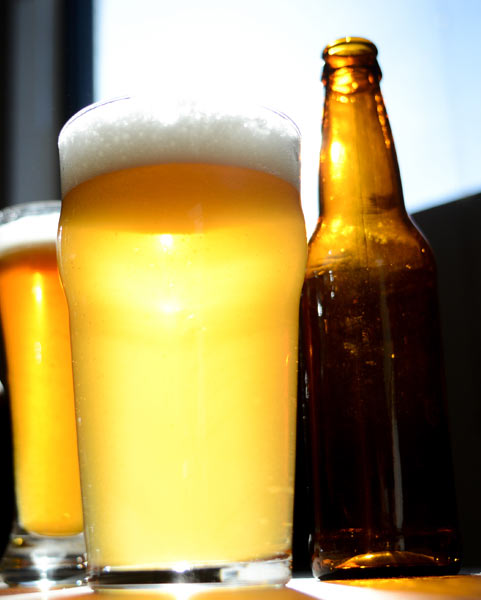It’s an unmistakable odor—the nose-wrinkling clue that a skunk has met its maker, or at least has been placed in peril. Sincere condolences to the critter’s kin, but I must admit: I don’t really mind the smell.
Years of watching Looney Toons has conditioned us to believe that Pepé Le Pew’s stench was only surpassed in strength by his come-ons. This opinion prevails in the beer world—skunky beer is bad—but I’m not the only one that isn’t totally repulsed by the skunky aroma.
Some brewers are not willing to write it off as a perennial off-flavor, either. Could it be that this obvious beer “flaw” might actually be a benefit in some instances?
What Causes Skunky Beer?
Skunky beer is caused by ultraviolet light, specifically UVB wavelengths, that split apart the alpha-acid molecules from hops. These dislocated hop particles combine with sulfurous molecules from the beer’s malt to create a new compound known as 3MBT, which is what causes the strong and recognizable skunky odor.
Given the hop-heavy nature of a lot of America’s craft styles, our beers are particularly susceptible to UVB radiation from the sun’s rays or a liquor store’s fluorescent lighting. This is why we preach that brown bottles are preferred over green: they excel at limiting the amount of light that can mess with our liquid gold.
There’s no question, light does affect your beer. If I’m sitting on a patio in the Colorado sun, the reaction can happen in minutes and is easily detectable. I am indeed “that guy” erecting a fortress of menus around (and over) my IPA to protect it from UVB light.
Is There a Right Amount of Skunk?
Today, this “skunky” aroma is recognized as one of the common off-flavors that may be present in beer. Despite that, some brewers have opined that they can appreciate the character imparted by a touch of light through a green bottle.
There is no doubt that some of the classic beers produced in Belgium taste and smell different when served in green bottles versus on draft. As American brewers have worked to emulate such styles, many felt that their attempts were lacking a certain skunky something that only a green bottle could provide.
“I’ve had brown bottle versions of some of these beers, and have had them on draft as well and there is an element missing from those versions that the green bottles have,” wrote Jester King Brewery’s, now former, head brewer Garrett Crowell, who released a Belgian-style table beer, The Petit Prince, in green bottles. “While green bottles permit the risk of lightstruck or skunky character, I feel they add character even beyond skunkiness.”
And Jester King is not the only U.S. craft brewer that has “gone green.” Allagash Brewing’s Jason Perkins, who knows a thing or two about brewing Belgian-inspired styles, chooses to package his Coolship Series beers in green bottles—mostly due to the fact that the beers do not utilize a large amount of hops, thus there is less of a chance for the reaction to overwhelm the beer’s character. But Perkins does not put much stock in the idea that a beer can actually be improved by light.
“The prevailing thought that green bottles are bad for beer is mostly correct,” writes Perkins. “In a nutshell, the darker the bottle, the better it is for the beer, as it lets in less light and you get less lightstruck [character].”
“Brown glass is better! It’s better for all beer,” insists the normally reserved Chad Yakobson, founder of Crooked Stave Artisan Beer Project.
Yakobson rejects the idea that Belgian-style beers taste better with a bit of lightstruck character. “That is American thinking, it’s totally wrong. Lightstruck character is not part of Belgian beer [in Belgium],” he explains. “I do think there are many good arguments on both sides, but at the end of the day it has to be about quality!”
“I understand that green bottles and lightstruck character are going to be a challenge for most beer enthusiasts,” Crowell admits. “I think we’re in a unique and important position to break down some of the indoctrination.”
The Human Element of Beer
While skunk may not be appealing in general, I often think of something Tomme Arthur of Port Brewing and The Lost Abbey once said: “The funky brings out the pretty.”
Perhaps this is true of 3MBT—maybe a slight skunky character allows pleasant flavors to shine even brighter in contrast.
Sure, you wouldn’t want to smell the aroma of skunk in excess, especially in certain styles of beer. I am not suggesting you install fluorescent lighting in your beer cellar. But in the right beers, at the right levels, Jester King could be on to something.
By August, we might all have had some great beers that have been kissed by the sun. Hopefully, the fun we’re having outside is enough to balance any deterioration we taste. Meanwhile, the debate over whether a skunky aroma is a flavor or a flaw will continue, along with whether a bit of diacetyl is okay in a bitter or DMS in a helles.
I remember what my grandfather said, years ago, while ripping out a handful of marigolds that were growing in the sidewalk: “It’s a weed if it’s not growing where it supposed to.”
I never really believed that. And that’s the final element of the discussion of skunk—the human element. Can we or the environment around us have an effect on the final product after the beer leaves the brewery and yeast has done its job? Seems like we already do it, by aging beers or pushing them through randles. Should we? I’m not sure. What you like in your glass, or growing out of the sidewalk, is often out of the control of the brewer, gardener and anyone else. Ultimately, what matters is that you enjoy it. Personally, I like a slight skunky character provided by the sun—in certain situations, with certain beer styles. It’s the inevitable price of having a great summer.
CraftBeer.com is fully dedicated to small and independent U.S. breweries. We are published by the Brewers Association, the not-for-profit trade group dedicated to promoting and protecting America’s small and independent craft brewers. Stories and opinions shared on CraftBeer.com do not imply endorsement by or positions taken by the Brewers Association or its members.


Share Post